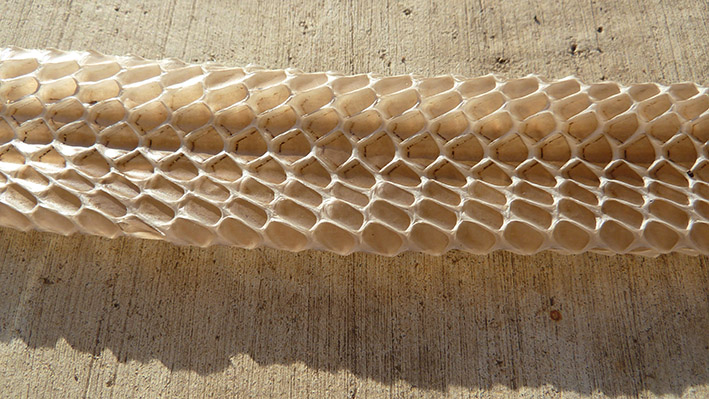I was watering “the grove” the other day – an area with a range of canopy layers between the outdoor toilet and the workshop – when a slithery movement on a grapefruit branch beside my head caught my eye and got my pulse racing. Seen briefly out of the corner of my eye it was definitely “snakey”.
Well it was “snakey” – the tail of a snake, moving on the branch. But this was no ordinary snake. It was pale and translucent and stretched back into the gloom under the dense canopy.
Definitely no ordinary snake. This was a ghost snake.
 The complete skin of a Green Tree Snake (Dendrelaphis punctulata) was stretched along the branch, then up to another branch and along that, with the head at the far end. As the light breeze moved the branches the tail moved backward and forward on the branch near me, looking at first glance as if it was alive.
The complete skin of a Green Tree Snake (Dendrelaphis punctulata) was stretched along the branch, then up to another branch and along that, with the head at the far end. As the light breeze moved the branches the tail moved backward and forward on the branch near me, looking at first glance as if it was alive.
It’s a pity I didn’t think to get the camera at the time, but it was getting dark and I still had chores to do. The next morning we gently gathered the skin from the branches and laid it out on the porch – all 1.75 metres of it (they grow to two metres). Apart from a small tear in the middle it was undamaged, leaving us wondering how on earth the snake got out of the old skin.
This is the longest Green Tree Snake we’ve seen and we’re pretty sure this one is an old friend that has been around here for ten years or more, first making our acquaintance when it took to sunning itself on the kitchen sink on winter mornings.
We see it regularly, most recently when it decided that the top of the “resting” composting toilet bin was a lovely place to soak up some warmth from the composting process going on in the bin. When we got too close it relocated into the top of the bin – even warmer, and no pesky humans – and no, it doesn’t smell (I’ll do a series of posts on our composting strategies in the near future).
This snake frequently climbs up the toilet vent pipe to the “whirlybird” ventilator on top and then through it and down into the pipe to look for Green Tree Frogs inside. Usually it’s only the grandfather Tree Frog that has been around nearly as long as this snake, and the snake has no chance of getting its mouth around that massive frog. That doesn’t stop it trying though, and we are alerted by the frog’s distress calls as the snake struggles to get its jaws open around the frog’s head. The end result is that the frog gets scratches on its back from the snake’s fangs and the snake is moved on by us.
This is probably the same snake, trying to climb the wall of the house two years ago (you can see the post about that here).

Back to the skin; its a fascinating thing of great beauty. The scale pattern varies along the body, and from the top to the underside.

 And here’s what the real living Green Tree Snake looks like. This isn’t our old friend but one that I saw down near the creek a year or so back.
And here’s what the real living Green Tree Snake looks like. This isn’t our old friend but one that I saw down near the creek a year or so back.
 These snakes are harmless, and generally not at all aggressive. The blue colour between the scales is a threat display and only appears when the snake expands its body make itself look larger and to expose the blue skin between the scales. This one raised its head to get a better look at me (I was crouching beside it to get a better angle to photograph it) and trying to “smell” me with its tongue.
These snakes are harmless, and generally not at all aggressive. The blue colour between the scales is a threat display and only appears when the snake expands its body make itself look larger and to expose the blue skin between the scales. This one raised its head to get a better look at me (I was crouching beside it to get a better angle to photograph it) and trying to “smell” me with its tongue.
You can find more about this species on the Queensland Museum website and Wikipedia, and quite a bit about its ecology at Critters of Calamvale Creek.


Nice find, beautiful docile snakes. Just so you know when measuring a snakes shed skin, the actual length of the snake is smaller than the shed. Usually about 20%-25% shorter, as when they snakes shed the skin it stretches. You can see in the shed the rings of skin around each scale which normally isn’t as exposed, the shed also includes both the top and bottom of each scale. Common Tree Snakes are excellent examples with this when you see one moving you will see the blue skin under the scales as it slithers and stretches a bit, people often tell me they have a blue stripped snake which is just the blue under the scales making diagonal “stripes” showing through as the snake moves.